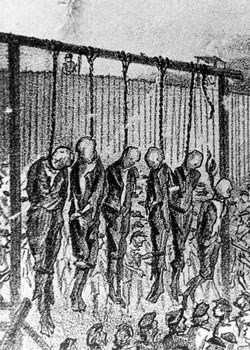
NPS Image For many people a visit to Andersonville is not complete without a visit to the Raiders' graves and theirs is one of the most frequently told stories of Andersonville. The Raiders' were often emphasized because they were a safe story to tell that would not incite sectional divisiveness. Northerners could talk about the Raiders as being rogue immigrants, and that good patriotic American soldiers didn't commit such atrocities. Southerners could talk about the Raiders as being a source of the troubles at Andersonville and deflect attention away from the prison's other issues. For authors and movie producers, the Raiders provided an action-packed drama that made for better story telling than a mass of sick prisoners. This overemphasis on the Raiders has created an impression that the Raiders define the Andersonville experience. But the simple truth is that these Raiders' reign and influence was very short lived. The first prisoners began to arrive in late February 1864, and gangs that would become the Raiders start to appear in May 1864. By the end of June they were arrested, and the six leaders were hung on July 11, 1864 – a full month before the prison would be at its worst. At the time the Raiders were arrested, there had been fewer than 3,000 deaths in the prison – meaning that some 10,000 prisoners died after the Raiders' reign ended. 
Turner Pictures Additionally, several of the Raiders were in the prison a relatively short period of time. According to tradition one of the six leaders, a sailor named Munn, was on board the USS Water Witch. The Water Witch was captured the night of June 3, 1864, which would mean Munn arrived in Andersonville probably sometime around the 10th. Around two weeks later he was arrested and tried as one of the six leaders of the Raiders. In the 1996 film, Andersonville, Munn is depicted as a grizzled veteran of the prison who greets the main characters with a large knife. The real-life Munn would have likely arrived at Andersonville after the characters in the film. The Raiders are undoubtedly an important part of the Andersonville story. They represent the choices faced by all prisoners of war – to what extremes are you willing to go to survive? As depicted in countless books and the 1996 film, most prisoners of war shunned the decisions made by the Raiders and fulfilled the motto of the prison's survivors: "Death Before Dishonor." However, they are not the dominant narrative of the prison's 14 month existence. |
Last updated: October 26, 2022
